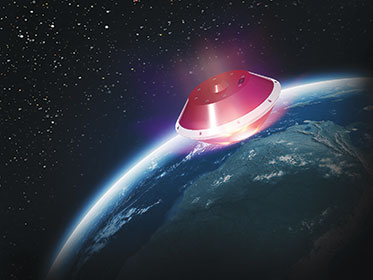

How did life actually form on Earth? Even today this question still has not been definitively answered. There are, however, signs that asteroids or comets played an important role. In the search for additional clues, space probes fly to these celestial bodies and collect samples. The capsules that return the material must withstand re-entry into the Earth’s atmosphere undamaged. Ensuring that this happens is the goal of the Hades project, which is sponsored by Faulhaber. In future, Faulhaber linear motors will help stabilise the movement of the capsules to ensure a smooth re-entry into the Earth’s atmosphere, thus preventing their destruction.
Stardust by the gram
The unmanned missions generally collect just a few grams of the cosmic material. Thanks to modern analysis methods, tiny quantities are sufficient for in-depth research on the processes that occurred during the formation of our solar system. The return capsules are released from the space probe. The Earth’s gravitational pull eventually forces them to land in a precalculated area.
Like all objects that enter the Earth’s atmosphere from space, the capsule becomes extremely hot in contact with the atmosphere but it is effectively protected by its round-oval shape and a heat shield. A critical phase of the return begins a brief time later after it has already been significantly slowed down by the air resistance and moves at ‘only’ subsonic speed.
Danger from aerodynamics
During this part of its flight, the capsule is already exposed to terrestrial aerodynamics. Every air eddy affects its trajectory and orientation. Without wings and flaps, there is no way to stabilise from the outside. To prevent this scenario, the orientation of the capsule needed to be stabilised during its flight through the atmosphere and the project team went for stabilisation though centre of gravity displacement.
The capsule should, in principle, do the same thing as a surfer when he holds onto his board while riding a wave: he compensates for the effect of his dynamic ‘ground’ by using his bodyweight to constantly adjust his centre of gravity. The compensating movement takes place on the x and y axes. By shifting a weight back and forth on both of these axes, it is possible to compensate for external destabilising forces.
Motors with double function
It made sense to use linear DC-servomotors inside the capsule to move the two weights. The motor mass was sufficient in this case to function as a counterweight. The stabilising effect was achieved by the two motors darting back and forth along their axes. Adding additional dead weight was not necessary. While searching for reliable solutions with linear motors for this task, experts from Hades turned to the solutions offered by Faulhaber. They were able to find a suitable drive in the portfolio based on the physical requirements for the unusual task.
These were considerable. First, they had to be relatively robust to withstand the enormous forces during rocket launch and upon re-entry into the atmosphere. Especially during the latter, it becomes very hot in the capsule – this after having been exposed to the extremely low temperatures in space and the vacuum present there. All of this could not prevent the motors from performing their tasks reliably and quickly. They had to move back and forth along their axis of motion up to four times per second. Significant deceleration and centrifugal forces had to be compensated for. At the same time, the space within the capsule was a very scarce commodity. The motor had to supply maximum performance with the smallest of dimensions.
The LM 2070-12 linear DC-servomotor from Faulhaber achieved the best values in all important points and proved to be the most reliable drive. It was also important that the motor control could be very easily programmed and integrated in the complete system. The entire system was tested in climatic and vacuum chambers as well as in the wind tunnel at the University of Geneva. There, the reaction of the capsule to the air resistance during the flight through the atmosphere was simulated. During the tests, the linear motors reliably stabilised the orientation of the capsule.
In the field test with an actual return from space, the capsule will be launched by a Rexus rocket from the Esrange Space Centre in Sweden. After accelerating to 20 G and reaching a top speed of 4300 km/h, it will travel to an altitude of 100 kilometres above the earth’s surface, from where the capsule will be dropped.
| Fax: | 086 653 5225 |
| Email: | [email protected] |
| www: | www.hornet.cc |
| Articles: | More information and articles about Horne Technologies |

© Technews Publishing (Pty) Ltd | All Rights Reserved